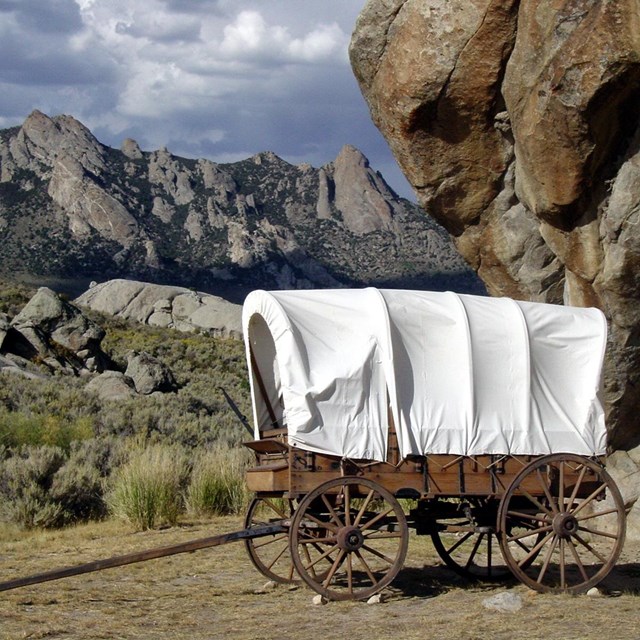Last updated: February 14, 2022
Article
Girl in a Sugar Barrel: Mary Elizabeth Snelling

Image/Courtesy Tuolumne County Historical Society
Could a 12-year-old girl fit inside a sugar barrel?
And why on earth would she want to?
Not much seems certain about Mary Elizabeth Snelling’s childhood circumstances except that she was African American and born in Johnson County, Mo., on February 4, 1839. Also this important fact: Mary Elizabeth, daughter of a Black woman and a white man, had light-colored skin.
Mary would have been 12 years old when she and her mother, Julia Snelling, accompanied William (or was it George?) Snelling’s family wagon train to California in 1851 – or 13 if they went in 1852, or only 10 if the family headed west in 1849, as some sources indicate. Mother Julia was, or at one point had been, held in enslavement by the Snellings, but a descendant of Mary attested that mother and daughter were free persons when they went west. If so, it seems they traveled willingly with the white family.
As an adult, Mary told her children and grandchildren that she rode to California in a sugar barrel tied to the sideboards of a covered wagon.
Now, families were generally advised to carried one hundred pounds of sugar in their wagons. One hundred pounds of sugar is about fourteen gallons. A modern, plastic fifteen-gallon container is about 23 inches high and 18 inches in diameter. According to her grandson, Vernon Sugg McDonald, Mary was “of tiny stature,” but that’s a tight fit for even a small child. So, instead, generously picture for her a common dry-goods barrel, like the antique Quaker-built barrel spotted for sale online: at 31 inches in height and 25 inches in diameter, it still would not be a very comfortable fit for little Mary.
Now imagine folding one’s body into a small barrel, knees under chin, elbows scrapng against rough boards, struggling to breath inside the closed container as the wagon jolts along under the blazing sun. Just—why?
In a 1964 article published in the Tuolumne Historical Society Quarterly, Mary’s grandson Vernon recounts what she told him about her trip west.
“Though the Indians threatened to steal our horses at night, they were friendly during the day and often rode into the train with freshly killed buffalo meat for trade,” she told him. “I didn’t know it but they were watching me closely all the time, and on one occasion an Indian made a strong argument to take me. After that my mother was told to hide me whenever the Indians approached the train.”
Perhaps they wanted to take Mary because her race was a novelty to them, or because she was small and pretty, but the story widely told today suggests that Indian traders thought, because of her light skin, that she was an Indian child who had been kidnapped by the emigrants. They simply wanted to take her back. She hid in the sugar barrel for protection.
So why not hide her inside a wagon where she could at least stretch out her legs?
“The covered wagons held little protection from sharp eyes and so I was hidden in the most conspicuous place – an empty sugar barrel that hung at the side of a wagon. I always hated being put in the barrel because it meant a rough, hot, and bumpy ride in the dark, sometimes for several hours,” Mary told her grandson.

Image/Courtesy Tuolumne County Historical Society
Perhaps the tactic worked. “We were never attacked by the Indians,” Mary recounted, “but the two wagon trains just ahead of us had been. We frequently came upon the smoldering frames and broken wheels of freight wagons, the bloated bodies of horses, broken gear, and sometimes the signs of freshly dug but smoothed over graves.”
The two wagon trains ahead of the Snelling wagons also suffered from the then-widespread cholera epidemic. Mary Elizabeth explained that her party’s wagon boss altered their route to avoid potentially infected areas, trailside campsites at contaminated springs and waterholes. Not understanding that cholera is bacterial, they also fought the deadly infection by wearing asafoetida —a gummy plant substance commonly called “devil’s dung”—in bags around their neck, believing that the stench would drive off the disease. One hopes that little Mary Elizabeth was not required to wear her asafoetida while riding in the barrel.
The Snelling wagon train eventually halted in the area of Merced, California, where Mary soon met William Sugg, a former slave who had purchased his own freedom for a dollar. The couple moved to Sonora, Calif., and wed in January 1855, just shy of Mary Elizabeth’s 16th birthday and William’s 26th. They purchased a corner lot t on Theall Street and (with the help of the local Black community) made bricks to build a three-room adobe house, which they enlarged through the years as their family grew to 11 children. William supported his family as a harness maker and teamster, but the family also rented out rooms to overflow guests from local hotels. Mary Elizabeth later converted the home into a boarding house. William died in 1889 and Mary died in 1915 at the age of 76. Their grandson, Vernon Sugg McDonald, lived in the family house on Theall Street until his death in 1982.

NPS Photo
Sugg House, listed on the National Register of Historic Places, can be visited today at 37 Theall Street, Sonora, Calif.
For Further Reading
McDonald, Vernal Sugg. 1964. The Pioneer Sugg Family. The Quarterly of the Tuolumne County Historical Society 4(1): 97-99.
Moore, Shirley Ann Wilson. 2016. Sweet Freedom’s Plains: African Americans on the Overland Trails, 1841-1869 (vol. 12) Race and Culture in the America West Series. University of Oklahoma Press, Norman. [An earlier version prepared for the National Park Service is available at SWEET FREEDOM’S PLAINS: African Americans on the Overland Trails 1841-1869 (nps.gov)]


